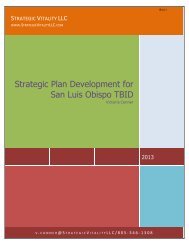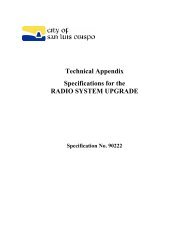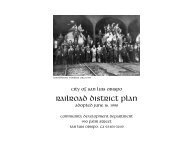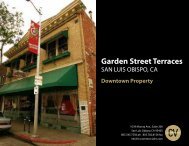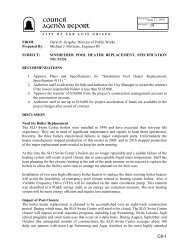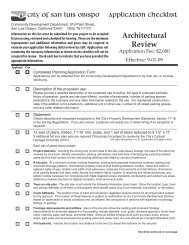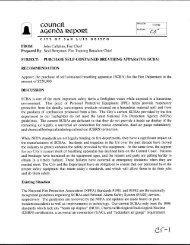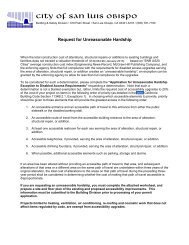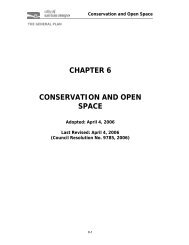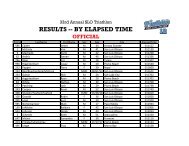Drainage Design Manual - the City of San Luis Obispo
Drainage Design Manual - the City of San Luis Obispo
Drainage Design Manual - the City of San Luis Obispo
You also want an ePaper? Increase the reach of your titles
YUMPU automatically turns print PDFs into web optimized ePapers that Google loves.
SECTION 7.0DESIGN OF CONDUITS, CULVERTS, AND OPEN CHANNELS FOR MINORWATERWAYSThis section outlines <strong>the</strong> design criteria for closed conduits, and for minor waterways includingroadside ditches that have a design discharge <strong>of</strong> less than 1.0 cubic meters per second (36 cubicfeet per second). Minor waterways have a catchment area <strong>of</strong> less than 2.6-km 2 (1-mile 2 ) andshall be designed for a minimum storm recurrence interval <strong>of</strong> years, with 0.3-m (1-ft.) <strong>of</strong>freeboard (Section 5.2).This section also addresses <strong>the</strong> hydraulic analysis and design <strong>of</strong> run<strong>of</strong>f that drains onto andacross improved surfaces such as streets, residential and commercial areas and parking lots and<strong>the</strong>n into storm drains via drop or curb inlets. The storm drainage is <strong>the</strong>n conveyed into a naturalor improved open channel.The design discharge and street flow hydraulics are to be determined following <strong>the</strong> procedurescontained in <strong>the</strong> Federal Highway Administration’s Urban <strong>Drainage</strong> <strong>Design</strong> <strong>Manual</strong>, HEC-22(FHWA 2001, 2 nd edition). This document includes procedures for determining run<strong>of</strong>f frompaved areas, gutter flow, and <strong>the</strong> hydraulics <strong>of</strong> drop inlets and curb inlets, storm drains andculverts, pump stations, and minor open channel flow using normal depth methods <strong>of</strong> analysis.In some situations, a backwater hydraulic model should be used in <strong>the</strong> hydraulic analysis. TheFHWA <strong>Design</strong> <strong>Manual</strong>, HEC-22, is available online at http://fhwa.dot.gov/bridge/hec22.pdf.Street and <strong>the</strong>ir associated underground drainage system must be designed so that <strong>the</strong>y convey<strong>the</strong> 100-year run<strong>of</strong>f such that <strong>the</strong> water surface elevation is at least 1-foot below <strong>the</strong> finish floor<strong>of</strong> adjacent structures, in conformance with <strong>the</strong> provisions <strong>of</strong> Section 3.5.As part <strong>of</strong> this analysis, <strong>the</strong> engineer shall consider <strong>the</strong> overall safety <strong>of</strong> adjacent developments.This process includes understanding what happens for events larger than <strong>the</strong> 100-year, and alsowhat happens if critical drainage devices become blocked with debris. <strong>Drainage</strong> overflow pointsor secondary outlets that anticipate such occurrences shall be designed into <strong>the</strong> overall drainagesystem.All stormwater system elements (including, but not limited to conveyance systems, stormwaterdetention facilities, and vegetated corridors) shall be designed and constructed in accordancewith all applicable rules and regulations <strong>of</strong> <strong>the</strong> <strong>City</strong> and County stated in this <strong>Manual</strong>. Anyinterpretations, must be consistent with applicable referenced technical guidance manuals, andwith all applicable federal, state and local statues and rules.The designer <strong>of</strong> <strong>the</strong> storm drain system will have to use good pr<strong>of</strong>essional judgment whendealing with <strong>the</strong> constraints and conflicts with existing infrastructure. When <strong>the</strong> designengineers have to deviate from <strong>the</strong> standards and criteria contained in <strong>the</strong> <strong>Manual</strong>, <strong>the</strong>y shouldcontact <strong>the</strong> <strong>City</strong> or County as soon as possible to explain <strong>the</strong> situation and come to an agreementon <strong>the</strong> solution.SLO Creek <strong>Drainage</strong> <strong>Design</strong> <strong>Manual</strong> 85 February 2003



